When you or your child gets sick-fever, sore throat, cough-it’s natural to wonder: is this bacterial or viral? The answer changes everything. Take the wrong approach, and you could be wasting time, money, or even contributing to a global health crisis. The truth is, bacterial infections and viral infections look almost identical at first. But they’re fundamentally different in how they work, how they’re treated, and what happens if you mix up the two.
What’s Really Going On Inside Your Body?
Bacteria are tiny, single-celled living organisms. They can survive on their own-in soil, water, or even on your skin. Some are harmless, others cause disease. When they invade your body, they multiply quickly, often doubling every 20 minutes under the right conditions. Think of them as little factories that break down your tissues and release toxins, triggering inflammation and fever.
Viruses are not alive in the way bacteria are. They’re just genetic material-DNA or RNA-wrapped in a protein shell. They can’t reproduce on their own. To multiply, they have to sneak into your cells, hijack their machinery, and turn them into virus-making factories. Once they’ve used up the cell, they burst out and infect others. That’s why viruses spread so fast and why your body has to mount a full immune response to fight them off.
This difference explains why antibiotics work on bacteria but do absolutely nothing to viruses. Antibiotics attack bacterial cell walls or stop protein production-things viruses don’t have. Giving antibiotics for a cold or the flu is like using a wrench to fix a broken lightbulb. It won’t work, and it can cause harm.
Common Infections: Know Which Is Which
Not all infections are created equal. Here are the most common ones you’ll encounter:
- Bacterial infections: Strep throat (caused by group A streptococcus), urinary tract infections (UTIs), tuberculosis, pneumonia from bacteria like Streptococcus pneumoniae, and some sinus infections.
- Viral infections: Common cold (rhinovirus), flu (influenza), COVID-19 (SARS-CoV-2), chickenpox (varicella-zoster), and most cases of bronchitis and ear infections in children.
Global data shows how widespread these are. Strep throat affects over 600 million people every year. Tuberculosis, a bacterial disease, sickens 10.6 million annually. Meanwhile, the flu infects between 9 and 41 million Americans each year. Before vaccines, chickenpox hit 4 million people globally every year.
And here’s something most people don’t realize: even when you have a viral infection, you can develop a secondary bacterial infection. About half of hospitalized COVID-19 patients end up with bacterial pneumonia on top of the viral illness. That’s why doctors sometimes prescribe antibiotics-even when the main problem is viral.
How to Tell Them Apart (Without a Lab Test)
Doctors don’t always have time to run tests. So they look for patterns. Here’s what to watch for:
- Speed of onset: Viral infections usually come on fast-fever, sore throat, and body aches all hit within hours. Bacterial infections often creep in more slowly, getting worse over days.
- Fever: A fever above 101°F (38.3°C) is more common with bacterial infections. Viral fevers are usually lower, under 100.4°F (38°C), but can spike.
- Duration: If you’re getting better after 5-7 days, it’s likely viral. If symptoms last more than 10-14 days, or you start feeling better then suddenly get worse, that’s a red flag for bacterial infection.
- Symptom type: Runny nose and cough? That’s usually viral. Thick yellow or green mucus? Not always bacterial-it can happen with viruses too. But if you have white patches on your tonsils, swollen lymph nodes, and no cough, it’s more likely strep throat.
The Centor Criteria-a clinical tool used by doctors-scores symptoms to estimate strep risk: fever, no cough, swollen lymph nodes, and tonsil exudate. Three or more points means a 50-55% chance it’s bacterial. That’s when a rapid strep test makes sense.

Why Antibiotics Are Dangerous When Used Wrong
Every year in the U.S., doctors write 47 million unnecessary antibiotic prescriptions for viral infections. That’s not just a waste of money-it’s dangerous.
Antibiotics don’t just kill bad bacteria. They wipe out the good ones in your gut, skin, and mouth. This disruption can lead to Clostridioides difficile (C. diff) infections, which cause severe diarrhea, colon damage, and kill over 12,800 Americans each year. It’s a direct result of overusing antibiotics.
Worse, every time you take an antibiotic when you don’t need it, you help bacteria evolve. They adapt. They become resistant. The World Health Organization calls antibiotic resistance one of the top 10 global health threats. In 2019, drug-resistant infections killed 1.27 million people worldwide. By 2050, that number could hit 10 million-more than cancer.
And it’s not just adults. Kids get six to eight viral upper respiratory infections a year. Most don’t need antibiotics. But when parents demand them, doctors sometimes give in. That’s how resistance spreads-from homes to clinics to hospitals.
Treatment: What Actually Works
For bacterial infections, antibiotics are lifesavers. But they must be targeted. Penicillin for strep throat, ciprofloxacin for UTIs, isoniazid for tuberculosis. Treatment usually lasts 5-14 days. Stop early? The strongest bacteria survive and come back stronger.
For viral infections, there’s no magic pill-except in a few cases. Antivirals like oseltamivir (Tamiflu) can shorten the flu by 1-2 days if taken within 48 hours of symptoms. Remdesivir helps hospitalized COVID-19 patients. Acyclovir reduces chickenpox severity. But for the common cold? No antiviral exists. Treatment is rest, fluids, fever reducers, and time.
That’s right: time. Your immune system is the real hero. It takes 7-10 days to clear most viruses. No pill can speed that up. Trying to rush it with antibiotics only makes things worse.

New Tools Are Changing the Game
There’s hope on the horizon. In 2020, the FDA approved the first rapid test-called FebriDx-that can tell bacterial from viral infections in 10 minutes by measuring two biomarkers: CRP (inflammation) and MxA (viral response). It’s 94% accurate. If used widely, it could cut unnecessary antibiotic use by half.
Researchers are also testing phage therapy-using viruses that infect only bacteria-to treat drug-resistant infections. Early trials in Europe show 85% success. And scientists at the University of Queensland are developing new compounds (IMB-001 and IMB-002) that target bacterial surfaces in ways antibiotics can’t.
Even vaccines are evolving. Universal coronavirus vaccines are now in Phase III trials. If they work, they could prevent future pandemics before they start.
What You Should Do Next
Don’t pressure your doctor for antibiotics. If you’re sick, ask: “Is this bacterial or viral? Do I need a test?” If you’re told it’s viral, trust that. Rest. Hydrate. Take Tylenol or ibuprofen if needed. Monitor your symptoms. If you don’t improve in 7-10 days-or you get worse-go back. That’s when testing makes sense.
Teach your kids that getting sick isn’t weakness. It’s your body fighting back. And don’t save leftover antibiotics for next time. They expire. They’re not safe. And they won’t help the next infection.
Every time you use an antibiotic correctly-or refuse it when it’s not needed-you’re helping protect the next generation. Because when antibiotics stop working, we all lose.
Can a viral infection turn into a bacterial infection?
Yes. After a viral infection like the flu or COVID-19 weakens your immune system, bacteria can move in and cause a secondary infection-like bacterial pneumonia or sinusitis. This is why some patients with viral illnesses end up needing antibiotics, even though the original cause was viral.
Are green mucus or thick phlegm signs of a bacterial infection?
Not necessarily. Green or thick mucus can happen with both viral and bacterial infections. Your immune system releases white blood cells and enzymes that change mucus color as it fights off germs. Color alone isn’t a reliable indicator. Duration and overall symptom pattern matter more.
Why don’t doctors always test for bacterial infections right away?
Many viral infections resolve on their own without treatment. Testing takes time and money, and most cases don’t need it. Doctors use symptom patterns and clinical tools like the Centor Criteria to decide when testing is likely to change treatment. For example, a child with a runny nose and low fever probably doesn’t need a strep test.
Can I use leftover antibiotics from a previous illness?
Never. Antibiotics are prescribed for specific infections, at specific doses, for specific lengths of time. Using old antibiotics can be ineffective, dangerous, or contribute to antibiotic resistance. Always get a new prescription if you’re sick again.
How long does it take to recover from a viral infection?
Most viral infections like colds or the flu improve within 7-10 days. Fever usually breaks in 3-5 days. Coughs can linger for up to two weeks as your airways heal. If symptoms last longer than 14 days or worsen after 7 days, see a doctor-it could be a secondary bacterial infection.
Is it true that antibiotics don’t work on the flu?
Yes. The flu is caused by a virus. Antibiotics target bacteria, not viruses. Taking them for the flu won’t help you feel better faster and increases your risk of side effects and antibiotic resistance. Antivirals like Tamiflu can help-but only if taken early.
What can I do to prevent bacterial and viral infections?
Wash your hands often, get vaccinated (flu, COVID-19, pneumococcal), avoid close contact with sick people, and don’t share drinks or utensils. Good sleep, nutrition, and stress management also help your immune system stay strong. Prevention is always better than treatment.

